Table of Contents
Among your strategic initiatives, pairing innovation with execution is most likely to yield the biggest results. But as we discuss in this article, many organizations are unable to match their organization’s ability to develop a strategic planning process with their organization ability to functionally execute strategy.
Successful strategy execution is the separator between companies that last and companies that talk a big game but quickly disappear. In the worst cases, they become case studies in developing unattainable strategic goals. Business textbooks are filled with such failures.
Strong execution companies use a strategic execution framework that matches their core values and enacts process improvements that build on their core activities to produce innovative products and services. They grow by remaining true to themselves and their abilities, understanding the resources required for meaningful innovation, and executing on their plans.
The essence of strategy is choosing what not to do.
Michael Porter
Here, we discuss the basic philosophies behind a strategy execution framework and how it can help an organization meet its strategic goals. As always, more information is available throughout the Digital Leadership website, and in the book How to Create Innovation. We welcome your questions and feedback.
Laying the Foundation for Innovation & Strategy Execution
An organization’s ability to successfully develop innovative products is based largely on the preparation that goes into its business strategy and how effectively it executes that strategy.
Plenty of people like the word “strategy” in business; it implies consideration, expertise, forethought. At Digital Leadership, we like to switch the focus over to “execution.” Your company strategy equals exactly nothing if the business can’t properly put that strategy into motion. Having strategic objectives in place is useless without a map for reaching them.
For us, that map is your strategy execution framework, an outline for a process that identifies your strengths and how to leverage them into exciting and profitable new products and services. Additionally, it cements into your organization a mindset of innovation that echoes throughout your hierarchy, across business units and functional silos. In fact, through strong execution, these divisions within your company’s operations will cease hindering your strategic planning.
How to Play to Your Strengths
Innovation is first of all about having the right mindset. Are you playing to win? Or are you merely playing to avoid losing? Organizations playing to win take chances and seize opportunities. Organizations playing to avoid losing concentrate on staying safe, not making any errors, and avoiding risks. These organizations tend to focus on cost-efficiency and cost-cutting and work on getting more performance out of what they have. There is nothing wrong with that. But if you focus on that for long enough, you will eventually be swept away by the next wave of disruption.
And what happens to the playing-to-win organization that took chances and invested in opportunities in the meantime? They are most likely miles ahead. As the fabled management guru, Peter Drucker put it more than half a century ago,
The business enterprise has two and only two basic functions: marketing and innovation. Marketing and innovation produce results; all the rest are costs.
Peter Drucker
The Unfair Advantage
The start-up world likes to talk about finding an “Unfair Advantage”: an advantage that allows you to leave the competition behind you and play in a space that is not packed with competitors. A sustainable advantage is one that cannot be easily copied or bought.
Read More: Unfair Advantage: What is it, and how do you find yours?
But which Unfair Advantages do you have as an established organization compared to a start-up? After all, you are not nimble; you are more risk-averse; you have somewhat hefty overhead; and you are less flexible.
Leveraging Your Strengths
The key is to focus not on what you don’t have, but rather on what you do. As a large organization, you have major assets you can use to your advantage. For example, you have a brand; you have existing customer relationships and thus customer access; you have deep technical expertise in specific areas; you have buying power; you have distribution relationships; you possess financial resources; and you probably have a ton of other assets and capabilities. A start-up has none of these things, nor likely do many of your competitors. These are the things that can form the basis of your own Unfair Advantage if you use them well!
As a principle, every innovation you create should leverage the existing strengths that your organization already has; this is the one sure way to gain an advantage on the competition since no one else in the market can leverage your unique strengths. This is the recipe to create a substantial, and hopefully even unfair advantage since it caters to your existing strengths.
Understanding Relevant Strengths
Some strengths are internal to your organization, and some are external.
Both internal and external strengths are relevant and can be a source of differentiation. From a portfolio-management perspective, you could also cluster different initiatives together that leverage similar strengths (for example have all marketeers across different initiatives leverage the same online marketing means and B2C customer database).
Not all strengths are created equal, however. Some contribute to your differentiation while others are unlikely to do so. How can you tell the difference?
Strategies to Identify Your Strengths
There are a few different ways to identify and assess your strengths; here are three that have worked for those of us at Digital Leadership.
1- Brainstorming, Creative Idea Generation & Interview
The simplest way is to brainstorm and build on the ideas you generate through a series of interviews with the senior business executives in your core organization. This approach will uncover some of your greatest strengths quickly. However, based on our experience, it will often not go far enough, since many firms are simply not used to reflecting on their assets and capabilities, and so asking people what they think their differentiating strengths are may not yield a full and accurate picture.
Read More: Idea Generation Techniques: How to inspire new ideas that Drive Innovation?
2- Work with a Capability Map
If you want to take a more systematic approach, our best advice is to work with a Capability Map.
Capabilities are the processes, systems of knowledge, and specific skills that a firm possesses based on which it operates, earns revenue, and competes with other firms. Capability Maps summarize the capabilities of a firm visually. They can exist at different levels of an organization—from an abstract list of capabilities at the enterprise level (such as in the chart we see here), or a much more detailed visualization when focusing on the particular capabilities of organizational units or even something like the IT system.
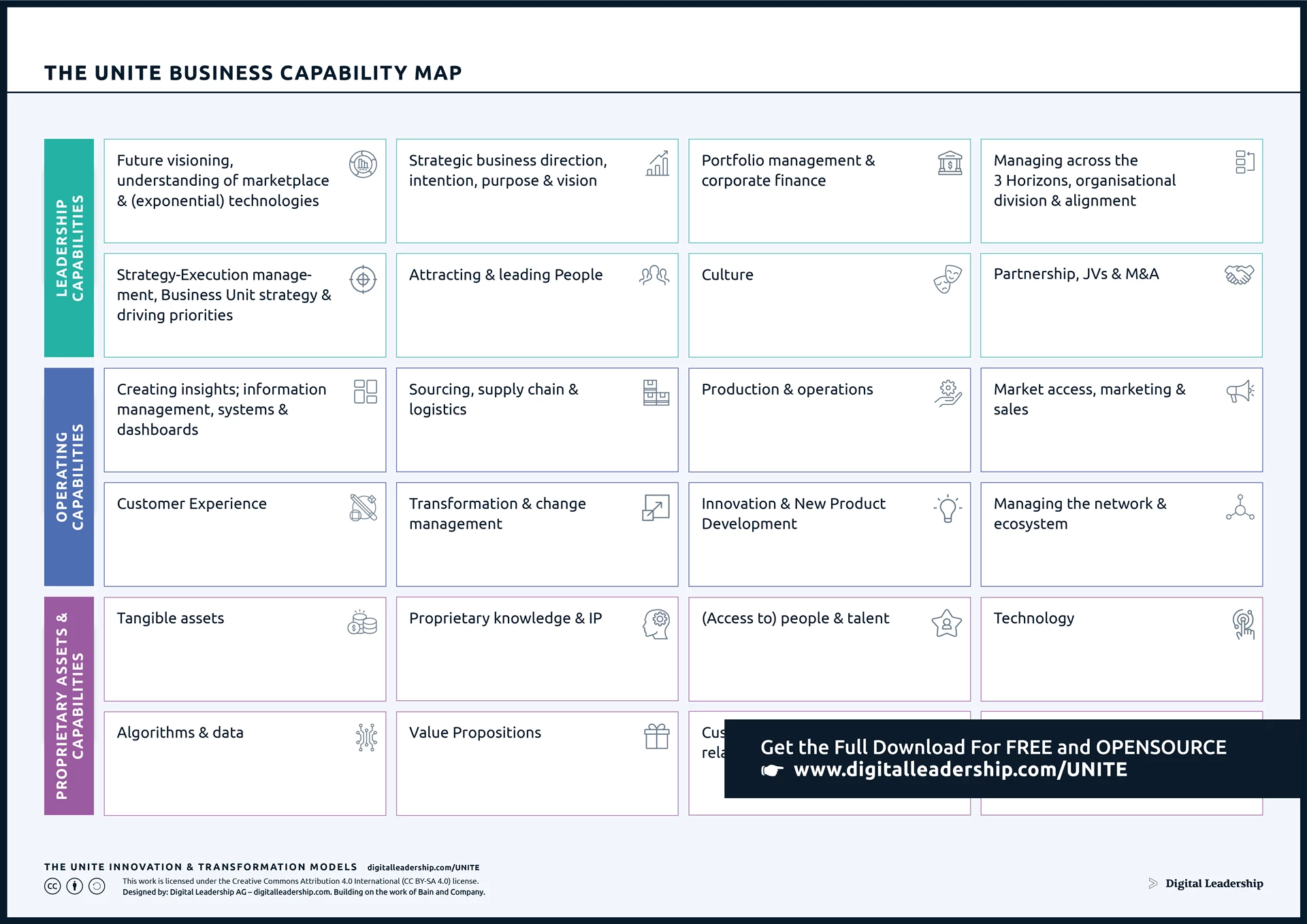
Designed by: Digital Leadership AG – Building on the Work of Bain & Company
Download the complete Business Capability Map package, including instructions for putting it to work for you today.
Such an analysis should allow you to determine the majority of your firm’s relevant strengths. To further deepen your understanding, you can conduct a more detailed mapping of specific parts of the organization. Your Enterprise Architecture team may already have a more detailed Capability Map covering certain aspects of your firm.
More information about Capability Maps–and a template for your own–can be found in How to Create Innovation.
3- Work with an Operating Model
A third alternative is to mine your Operating Model for strengths that distinguish you from your competitors. Operational excellence most-often occurs after a close examination of where a business is devoting energy and resources in relation to the desired outcomes.
Your operational system may be limiting you in ways you don’t realize. It’s also likely there are opportunities for improvement that you’re missing. It might not take an entirely new operational system to make significant changes. Small advances can have big, positive organizational implications, but only if you’ve taken the time to reflect on your operating model.
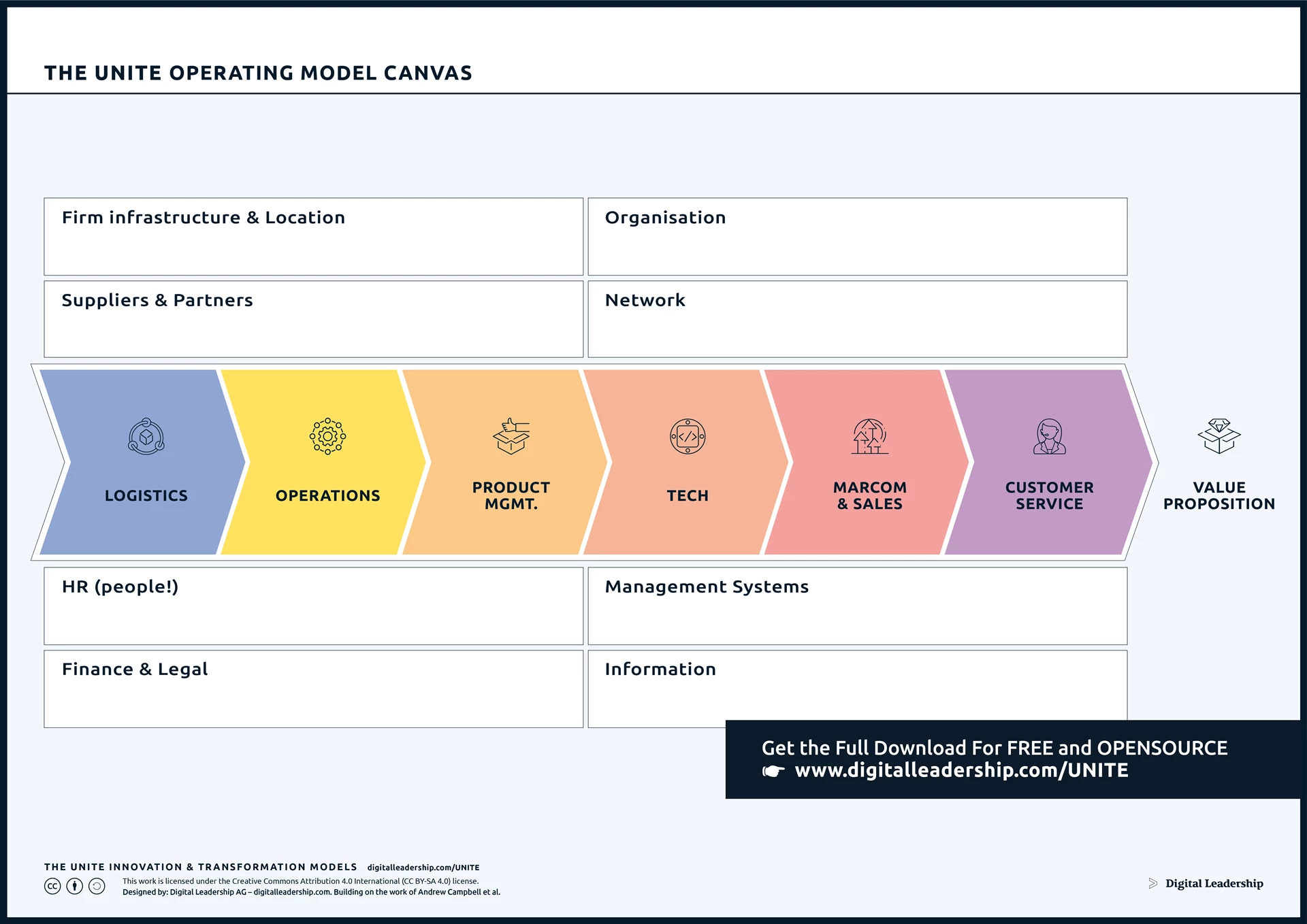
Designed by: Digital Leadership AG – Building on the work of Andrew Campbell at Al.
Your download is now available!
You can now access the complete Operating Model Canvas Package, including a full presentation, related models and instructions for use.
How to Create Innovation has extensive templates and canvases that you can use to reflect on how you do business and move your business forward. You can find it on Digital Leadership’s website.
Keys to Successful Strategy Execution
Most organizations do not lack strategy; they lack the ability to execute. This Strategy-Execution Gap is the primary concern of most CEOs, with 2/3rds of large organizations struggling to implement their strategies. Closing this gap is paramount—after all the best strategy or idea is not worth a dime if you can’t execute it!
Insource the Most Important Elements of Your Business Strategy
In the past, many organizations outsourced IT in order to cut costs. Now these same organizations are realizing that digitalization has become the key to Value Creation and that they are lacking the capabilities (and partially the assets) to execute digitalization effectively. This conveys a key lesson: digital capabilities that impact your core or differentiating areas should never be (fully) outsourced. And what goes for digitalization in general, also goes for an innovation team: you depend on technology and innovation, so don’t outsource it.
Give Innovation a Space to Breathe
Once an idea is approved, corporations often set up dedicated teams to manage it. To “control” and “support” an innovation, all kinds of structures and rules are put in place: governance boards, Stage-Gate, review cycles, etc. Eventually, the innovation team is told they must “use internal services,” or even, “IT will develop this for you. Just specify everything, and then it will move into the backlog.” This usually finishes with “these are your team members” and “now wait for headquarter approval.” All of this comes on top of procurement, legal, and HR madness.
What happens, in effect, is that the corporation applies the rules which guarantee its own successful core operation to the innovation idea. Failure to set up the innovation space as its own entity (a quasi- start-up) leads to dire consequences: typically, 2+ year timescales, very high costs, a total dependency of the innovation team on the core business and much lower quality products due to the lack of pivoting and customer validation. No innovation has a serious chance of success without freedom from the parent company. The CEO of a leading global insurance company was spot on when he told us, “When your (already quite successful) innovation project has 10,000 customers, you can bring it into our core organization. But not before. We will crush it with our weight and heavy processes.”
The takeaway is, do not chain the innovation speedboat to your core business container ship. Oversight and support cannot happen through the standard means a corporation uses for its own processes and projects. Instead, create a protected bubble where the innovation can flourish.
Of course, this doesn’t mean avoiding support or quality checks. With Digital Leadership as a partner, we will show you how you can achieve both within your strategic execution framework.
Start with a Committed and Complete Innovation Team
To successfully execute an innovation, you will require a committed team. It is critical to understand that this team must possess a few key characteristics.
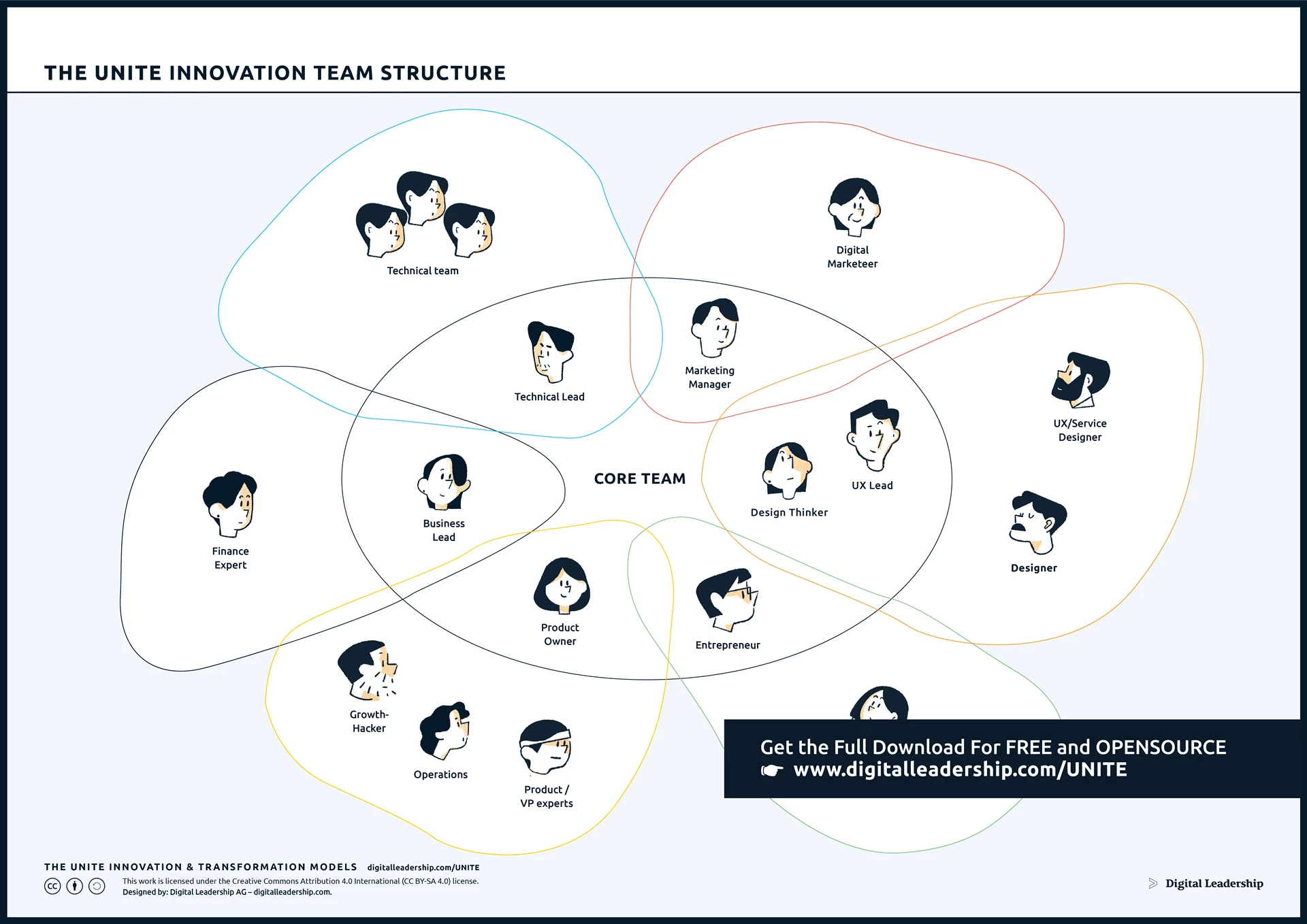
Designed by: Digital Leadership AG
Your download is now available!
You can now access the complete Innovation Team Structure Package, including a full presentation, related models and instructions for use.
- Independence: You want the team to function autonomously and be independent of any existing structure or management. Otherwise, they won’t have the freedom to experiment, learn, and make the required decisions. If you don’t trust the team to do so, you have the wrong team. Independence also means that the team is better off if they have their own distinct and designated physical space away from the core corporate structure.That doesn’t mean the team is insulated from your strategic goals. They should be as connected as everyone else, even if they are exploring how to succeed within your strategy execution framework in a different way.
- Full-time: You want the team to be full-time and 100% committed. A great way to kill innovation is to put a couple of people on the team at 20% or 50% capacity. In this situation, they spend so much of their time catching up on what’s happening, that they never get around to doing anything.
- But temporarily assigned: Innovations do fail. So, it makes sense to form the team with the assumption that it will be a temporary, project-based group. This helps to prevent the mindset that innovation is a linear process that “must” conclude positively. If the idea turns out to be a success, you can consider reforming the team on a more permanent basis, retaining some of its current members.
- Strong digital competency: Some or possibly all of the team members should be digital and innovation specialists. Deep industry knowledge or deep understanding of the parent company is typically not required or desired at this stage; this is more often than not an obstacle to innovation rather than an aid.
- Entrepreneur-leader: You want a true entrepreneur to lead the team, someone who has been there, created (digitally enabled) innovation, and growth-hacked something. You certainly do not want a project manager to project manage the endeavor into a well-organized failure.
Start on a Strong Foundation
A true innovation mentality is necessary to successfully innovate. Do not settle for less. Successful innovation is difficult enough, if you start out with a suboptimal setup, it will make it much harder. If you create a strong foundation, you will have more confidence in letting the project unfold as it needs to. Also avoid sticking rigidly to a plan: innovation initiatives have to adjust course as they make progress and as the team learns. Agility is key. You can’t foresee where your innovation will take you. Last but not least, avoid strong dependencies of your innovation initiative on the core organization—at least initially. You do not want to be crushed by the weight of primary business strategy and core activities.
The UNITE Strategy Execution Framework
The UNITE Strategy Execution Framework creates a common foundation that project leaders and field and line employees can use to guide strategic decisions. Because poor execution is so frequently the root cause of failures in innovation, the execution framework provides a common language that drives innovation.
As you’ll see, most organizations lack a clear path for innovative project success. We scaffold all possible concerns by dividing business operations into three areas: non-core activities, core activities, and areas of differentiation.
You can use these areas as you start strategy creation to investigate where you need to invest, as well as where you need to cut back.
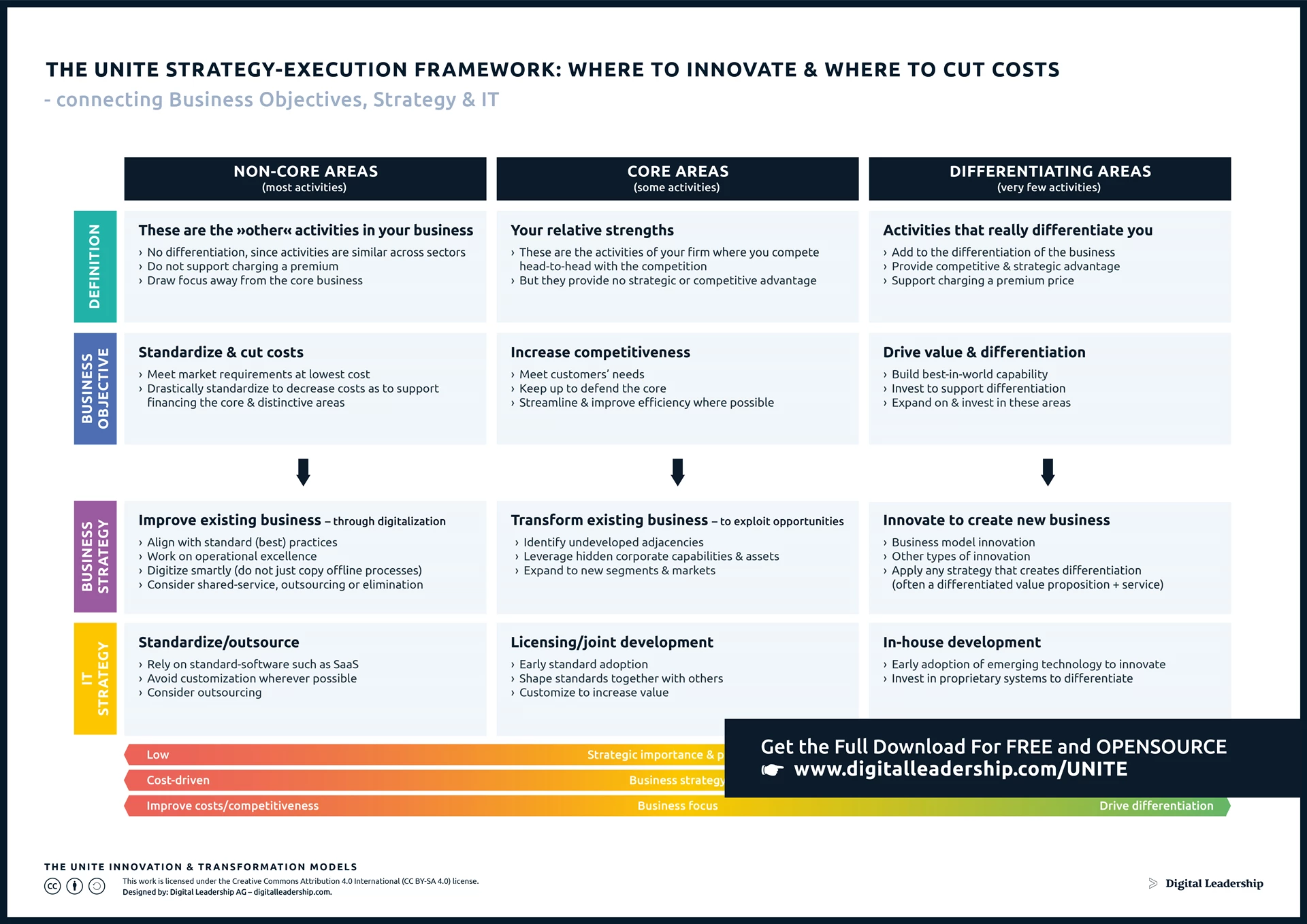
Designed By: Digital Leadership AG
Download the Complete Model package, including instructions for putting it to work for you today.
How Does the UNITE Strategy Execution Framework Work?
Because all of the canvases and models we’ve created under the UNITE umbrella take a holistic view of business strategy, we believe anyone tasked with developing a company’s strategic plan would benefit from consulting our book, How to Create Innovation. It includes a complete model of the Strategy Execution Framework, including the spectrums connected to building blocks of your overall approach: the importance level of certain strategic initiatives, overall business strategy (from a cost-driven approach to a value-driven approach), and your overall business focus (from improving your current competitiveness to driving differentiation).
These three components are directly responsible for the success of your company plans and will determine your ultimate destination. We invite you to consult the book, available from the Digital Leadership website.
In the meantime, we can look at the activities through which your organization delivers value, and consider how they fit into the Strategy Execution Framework.
Non-core Activities
Most of your organization is made up of non-core activities: entire areas such as accounting, forecasting, marketing, and HR, are not even sector-specific and thus generally do not add to the differentiation of your organization. In these areas, you can increase efficiency or decrease costs, but further investment in these areas is unlikely to add to your competitive advantage.
Core Activities
Your core activities are industry-specific and are areas where you possess relative strength. However, here you are competing head-to-head with other firms and are not superior to them.
Areas of Differentiating
Now contrast these with your differentiating areas. These are the activities where you are really different from other companies, and thus they are the areas that provide a competitive advantage. These differentiating activities (and thus assets and capabilities) generally represent a small percentage of your total activities (approximately 2%–5% of the total).
To summarize, when we are looking for strengths that support innovation, we need to be looking for assets and capabilities that are core or, ideally, differentiating, since these will support your competitive advantage.
Questions For Your Consideration
As you begin to think about setting up a space for your innovation, it’s time to reflect. Use these questions to ensure that you are setting yourself up for success.
Creating an unfair advantage
- Is the concept of “unfair advantage” understood in the organization?
- Has the organization identified based on which strengths an unfair advantage can be built?
- Do you have an understanding of which aspects of your business are Non-Core, Core or Differentiating as to be able to add differentiation to the points that matter?
Read More: Unfair Advantage: What is it, and how do you find yours?
Strategy Execution
- Have you created a true independent innovation setup for your innovation initiative separated from the core activities of your organization?
- Do you have an innovation team with the right kind of roles and skills? If not, where are the gaps and what do you need to change?
- Does the innovation team have the space to act?
- Do you outsource the right things (in the non-core areas)?
Understanding Your Customers’ Jobs
- Do you understand the Jobs-to-be-Done of your customers? What are you really helping to solve?
- Based on that understanding, who are you competing with?
- What can be done to strengthen your offering and positioning?
- Have you systematically tested your hypothesis with customers and done enough pivoting to optimally configure your product and business model?
Read More: Jobs to be Done Framework, Theory, Examples, and Statements JTBD
Execution
- Does your organization have a properly defined portfolio?
- Does this portfolio differentiate between customer-facing strengths and internal strengths and thus structure the initiatives in an effective way?
- Do you run a sufficient badge size of ideas?
- Do you have costs under control?
- Do you truly build real MVPs and thus work towards building the required investment security?
The UNITE Business Model Framework: A Framework for Innovation Success
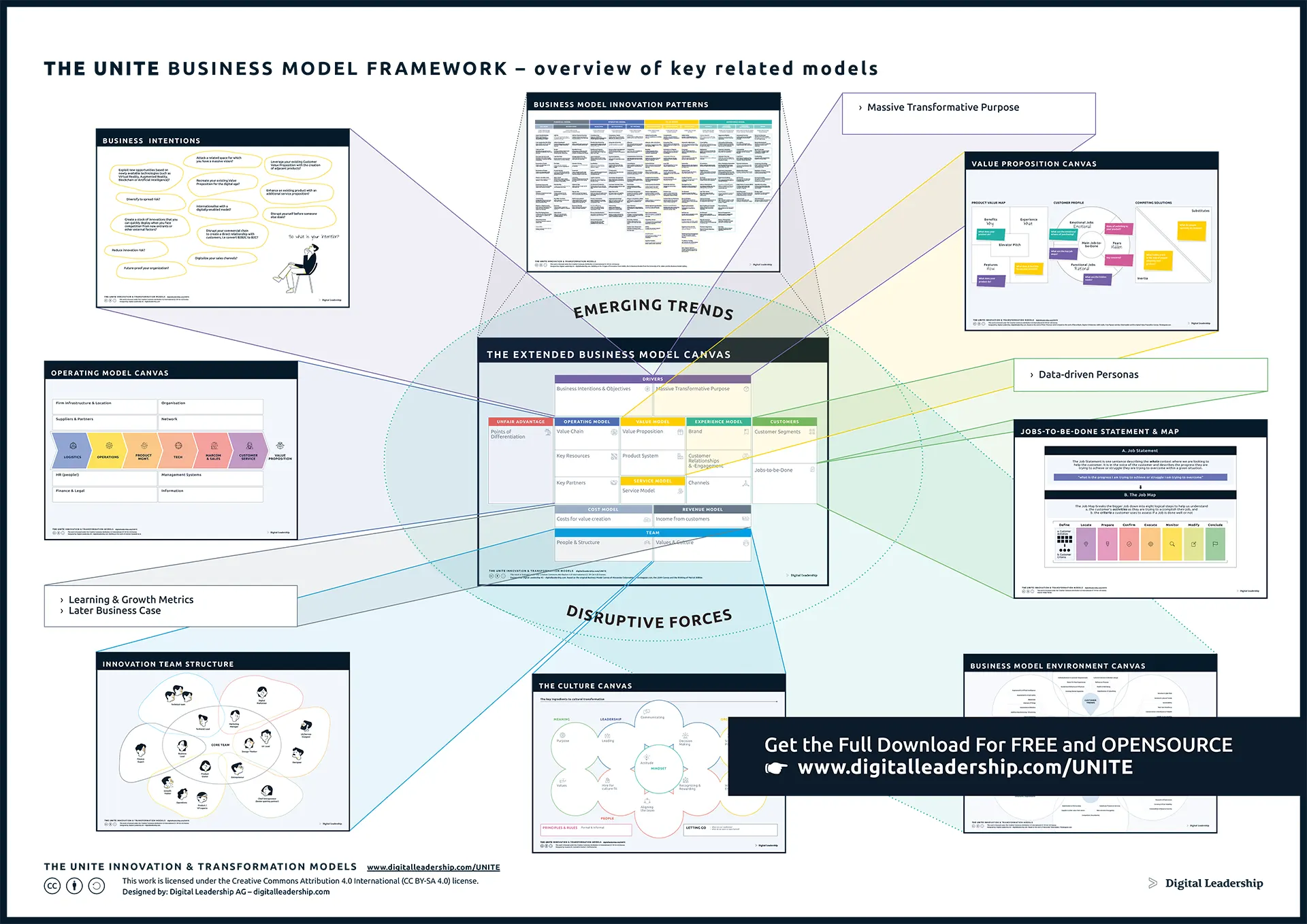
Designed By: Digital Leadership AG
Download the complete Business Model Framework package, including instructions for putting it to work for you today.






























 Book How to Create Innovation
Book How to Create Innovation